About
A pedestrian crossing leads from the Rue de la Loi into the Parc de Bruxelles, just in front of the Palais de la Nation (which houses the Belgian Parliament). Pedestrians crossing the street towards the park don't know that they're about to step on the largest cobblestone in Belgium when they reach the sidewalk on the other side. In fact, the limestone slab in front of the gate to the park is eight meters long, 2.55 meters wide and 20 centimeters high. Its weight is 10.6 tons.
This slab was presented in 1847 at the Exposition des Produits de l'Industrie nationale (National Industrial Products Exhibition) by Pierre-Joseph Wincqz, the manager of the largest quarry in Soignies, a town 35 kilometers southwest of Brussels that is famous for its limestone. It was installed in the pavement in 1852.
The laying of the paving stone in this district is the result of a history that began more than 70 years ago. As early as the end of the 1770s, Brussels was one of the first European cities to lay a pavement of some kind on the Place Royal. However, the purpose of the cobbles was not to separate pedestrians from horse-drawn vehicles—which were almost nonexistent—but to highlight the façades of the houses and protect them from dirt on bad weather days.
Especially in the 1820s and 1830s, new pavements appeared sporadically. The lack of a precise set of rules led to a visually cacophonous result. The 1830s and 1840s also saw an increase in the number of horse-drawn carriages, mainly due to the spread of public transport. Walking also became an activity for the bourgeoisie. These two factors necessitated the creation of wide, pleasant pavements (note that pedestrians were still given priority and it was still normal to walk on the road: walking on public roads was not banned until 1936) Finally, the Conseil de Salubrité Publique (Public Health Council)—established in 1836—asked the city to adopt pavement as the norm for the sake of public health. After 10 years of debate, the Organic Regulations of 1846 finally provided a clear and precise framework for the development of pavements throughout the city. ("Organic" because it aimed to ensure the coherence of all the elements of the urban space, from the buildings to the street furniture: the street became a total work of art.)
Simultaneously, the young Belgian state tried to give itself an image worthy of a real country. The new capital city was the focus of many urban development projects. In the Royal Quarter, which had already been largely built up in the 18th century, the emphasis was on the development of public spaces. This was to underline the importance of this place, which was the seat of the legislative and royal powers. It was in this context that the area around the Parc de Bruxelles was redeveloped between 1847 and 1852.
The large slab on the rue de la Loi is evidence of this first development in accordance with the 1846 organic regulations. It would later serve as an example for the rest of the city, which was expanding rapidly at the time. Although the surface of the flagstone had become completely smooth and thus slipping, no explanation was given as to why it was not replaced like the other flagstones on the sidewalk. Either way, this decision ensured the longevity of what is now regarded as the country's largest pavement.
Related Tags
Know Before You Go
The slab is on the pavement of Rue de la Loi, outside the northern entrance to Parc de Bruxelles, on the pavement opposite the Belgian Parliament.
It is sometimes slippery on rainy days or when it is covered with sand from the paths of the park next door.
Community Contributors
Added By
Published
October 8, 2024

























